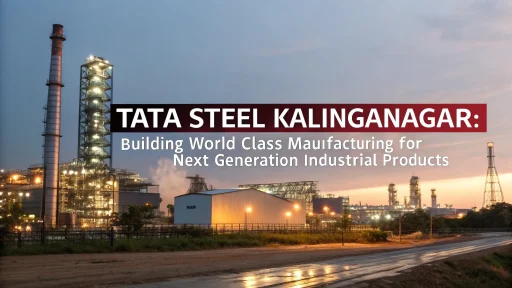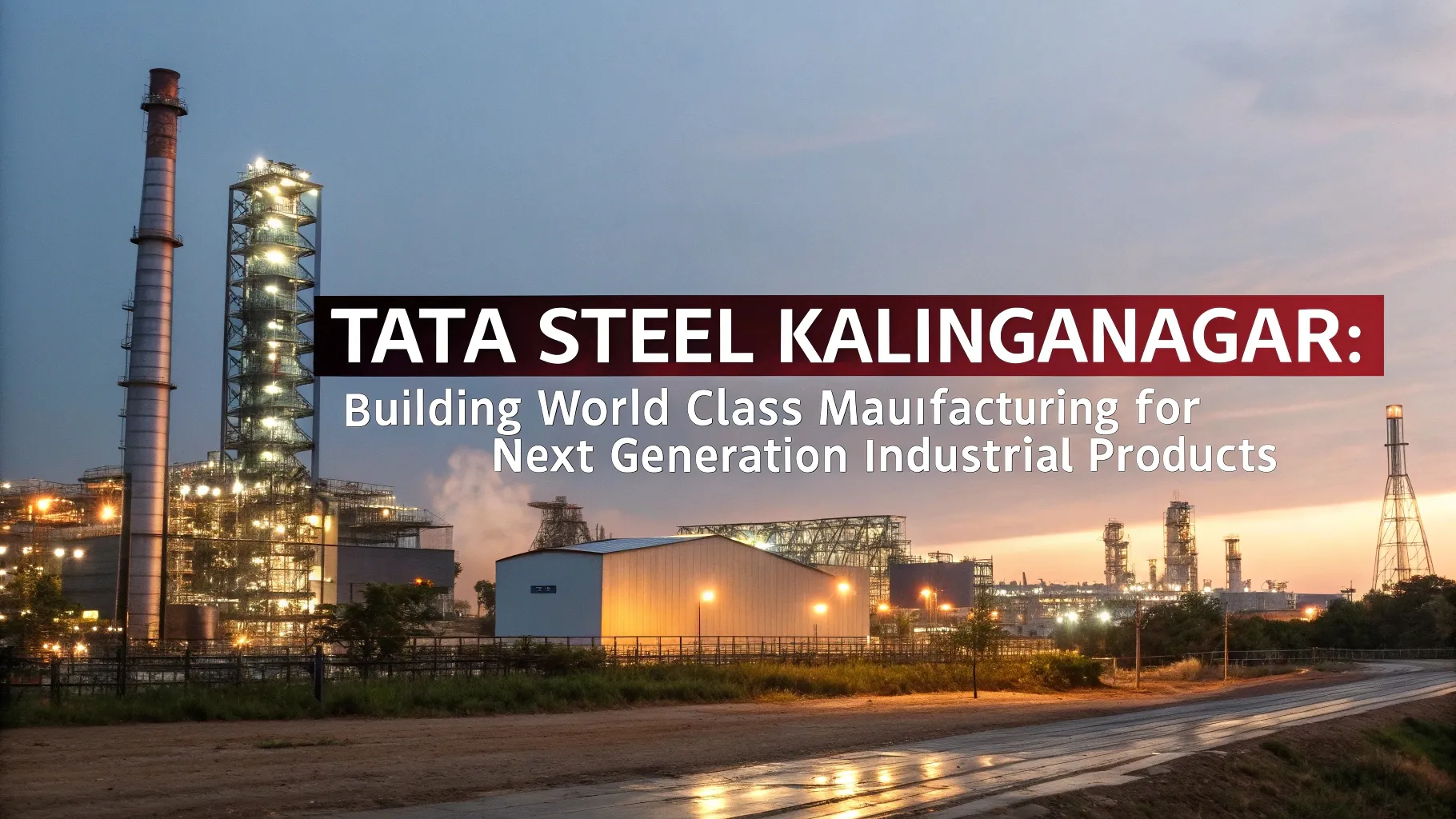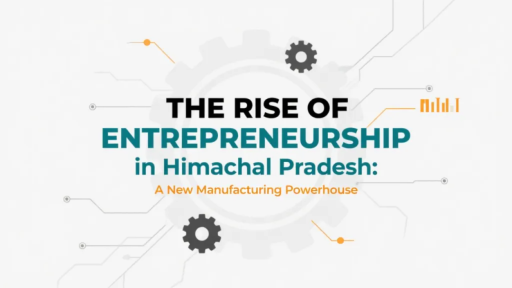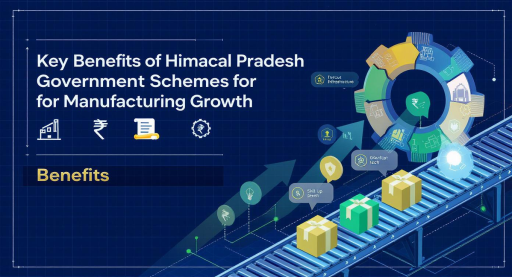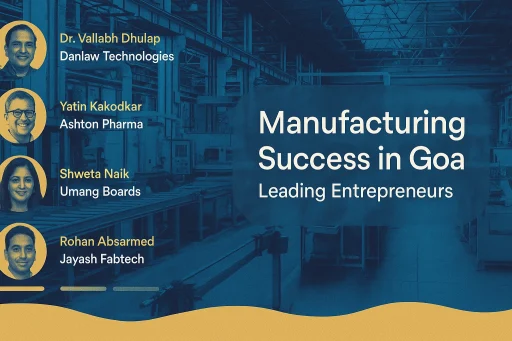Tata Steel Plant Kalinganagar: A Landmark in Indian Steelmaking
Tata Steel Kalinganagar facility in Odisha is a hallmark in the journey of steelmaking in India. Tackled as a greenfield project in order to avoid the limitations of older operations, it has rapidly transformed into one of the most sophisticated integrated Tata steel plant across the globe.
After the successful commissioning of a 3 MTPA (million tonnes per annum) Phase I project, Tata Steel invested ₹27,000 crore towards a transformative Phase II expansion that increases crude steel production capacity to 8 MTPA and contains India’s largest blast furnace.
Through cutting-edge metallurgy, digital manufacturing, and strong sustainability measures, Kalinganagar is prepared to offer high–strength next‑generation steels for automotive, infrastructure, defence, and energy industries. The plant provides an extensive ecosystem of collaboration including offering smart manufacturing solutions and co-developing advanced materials for the startups and entrepreneurs, as well as established companies.
Project Overview and Strategic Importance
With the completion of the Kalinganagar project, Tata Steel has put India on the global steel manufacturing map. A greenfield site encompassing 3,000 acres in Jajpur district, Odisha was selected so that a state‑of‑the‑art steel plant could be developed without being constrained by outdated expansions.
The site was located near coal and iron ore corridors, railways, and Paradip port to lower costs and speed delivery. Construction was initiated as soon as best practices had been incorporated, and the inefficiencies of traditional brownfield expansion were avoided.
Phase 1 was launched in 2016 to achieve a 3 MTPA capacity and was completed seamlessly. This success propelled the Kalinganagar project to serve as a template for “Atmanirbhar Bharat’’ manufacturing initiatives.
As of October 2023, Tata Steel maximized production in India, while Kalinganagar expansion plans remain underway.
Related: Tata Steel’s Product Innovation Journey: Industrial Startup Lessons
Phase II Expansion: Major Highlights
The Kalinganagar expansion, marked by the official opening in May 2025, signifies a major leap forward. A colossal 5,870 m³ blast furnace the largest in India with four top‑combustion and two preheating stoves anchors the expansion.
The new furnace raised crude steel output from 3 MTPA to 8 MTPA, making the plant one of the world’s largest single-site steel projects.The expansion includes a 4.3 MTPA pellet plant. It also features a high-efficiency coke oven battery. Advanced rolling mills with emission control and automation systems are added to meet India’s green standards.
Phase-Wise Comparison Table
| Parameter | Phase I (3 MTPA) | Phase II (8 MTPA) |
| Total Investment | ₹12,000 crore | ₹27,000 crore |
| Blast Furnace Volume | 4,000 m³ | 5,870 m³ (largest in India) |
| Pellet Plant Capacity | 2 MTPA | 4.3 MTPA |
| Coke Oven Battery | Conventional design | By-product gas recovery; heat recuperation |
| Rolling Mill Capacity | Single hot strip mill | Dual cold rolling mills; galvanising lines |
| Emission Controls | Standard ESP and scrubbers | Dry gas cleaning; zero liquid discharge |
This table summarizes how the scale and technological advancements of Phase II exceed the foundational infrastructure developed in Phase I. It illustrates Tata Steel’s transition from merely establishing capacity to prioritizing performance, sustainability, and diversified product offerings.
World-Class Manufacturing Technologies
Kalinganagar’s leap to world-class status encompasses four interwoven technological pillars.
First is the sophisticated blast furnace design with its upper divided combustion stoves and preheating stoves. These provide lower coke consumption coupled with greater hot-metal yield. Unique campaign refractory materials extend campaign life, which lowers maintenance costs.
The plant also integrates the world’s largest Top Gas Recovery Turbine (TGR). It converts waste gases into 35 MW of captive electricity. This system recovers about 10% of by-product energy for plant operations.
Along with a fully automated steel melting shop, there are dual hot strip mills. Precise automated systems, like taphole drills and ladle-handling robots, perform exact tasks. High-precision rolling technology produces coils with tight dimensional tolerances.
In cold rolling sections, coil ends are joined using Solid State Automatic Laser Welding. Strip quality is preserved. Automatic inventory systems reduce material handling.
Auxiliary units at Kalinganagar go beyond steelmaking and showcase innovation in processes. The granulated pellet plants use bag houses to filter particulates. The emission rate is just 10 mg/Nm³, well below the required limits.
The coke oven battery includes heat recovery systems. These systems reduce fossil fuel use by using thermal byproducts to power boilers.
Most remarkable is the focus on digitization. Using AI predictive algorithms for maintenance, Kalinganagar captures sensor data in real-time and can predict equipment failure up to weeks in advance.
With this real-time monitoring, the equipment can be guided into safe state, avoiding unnecessary downtime. Hot and cold strips also have surface defects monitored and corrected using video-analytics ensuring these products are ready when the customers expect them.
Through these smart technologies, Kalinganagar became a member of the World Economic Forum Global Lighthouse Network and achieved 7% to 10% improvement in throughput while annual savings of over ₹75 crore were achieved through energy efficiency and reduced downtimes.
Sustainability and Initiatives for Green Steel
While steelmakers continue to face intense scrutiny regarding their carbon footprints, Kalinganagar is notable for its special focus on sustainable development.
The new blast furnace design, along with dry gas cleaning technology which is more than 10% efficient than conventional gas cleaning furnaces, is an improvement.
Freshwater withdrawal is also reduced by 20% because of evaporative cooling systems, integrated rainwater harvesting systems, and zero liquid discharge infrastructures.
The closed loop water cycle of the plant reinforces conservation of resources, further minimizing costs related to effluent treatment.
Kata Steel plans to pilot blending green hydrogen into reheating furnaces. This step is expected to cut CO₂ emissions by 5% per ton of steel produced by 2026.
Furthermore, research into gas injection techniques on iron ore may provide further decarbonizing advantages. Moving towards carbon neutral steel production by 2045, these efforts are part of Tata Steel’s initiatives.
It goes without saying that the use of waste heat boilers captures off gas energy to fuel captive turbines and processes to granulate blast furnace slag into cement for construction aids in circular economy.
With Kalinganagar turning wastes into resources, the reliance on virgin resources is also minimized reflecting the self emphasis in sustainable metallurgy.
Innovative Portfolio of Industrial Products
The Kalinganagar modern infrastructure provides an integrated platform for a wide range of value added steel goods.
In the automotive industry, ultra high strength steels graded out to 1200 MPa are used in the advanced driver assistance systems (ADAS) since they reduce vehicle weight and improve crash safety performance at the same time. These steels help OEMs build safer fuel efficient vehicles by enabling redesigns of safety frames for improved fuel consumption increase.
For Construction and infrastructure athermomechanically treated (TMT) rebars and high strength profiles galvanized and pre painted coils manufactured in the plants galvanizing lines serve superb strength to weight ratio along with corrosion resistance required for offshore platforms, bridges, and high-rise buildings.
Moreover, pre painted galvanized coils provided with uniform coating thickness and increased durability are useful in construction cladding and in appliances manufakturing.
The navy ship builder and defense contractor have to deal with naval grade steels that carry military grade toughness and weldability for violent specification compliance, hulls, and drilling rigs for sea structures.
In energy sector, electrical steels with low core losses and high permiability are needed for transformers, motors and generators which makes them essential for power industry.
All these turns Kaliganagar into major supplier in this vital for india making strangle sectors region.
Related: 60+ Upcoming Industries in India You Can’t Ignore
Economic and Socio Community Impact
The expansion of Kalinganagar has not only strengthened Tata Steel’s position as a leading steelmaker, but has also contributed to the development of the Kalinga Nagar area. Direct employment at the site has risen to over 5,000 skilled and semi-skilled positions, while auxiliary sectors, for instance, fabricators and suppliers of spares, as well as service providers in logistics, have created approximately 20,000 additional positions.
Local Micro, Small and Medium-sized Enterprises (MSMEs) benefited from Tata Steel’s vendor development programs which furnish applicable training, quality assurance, certification, financing, among others, increasing regional entrepreneurial activity by 30% since 2023.
The additional community benefits facilitated by Tata Steel’s CSR initiatives are noteworthy. Students are trained in vocational fields including, but not limited to, welding, instrumentation, and information technology (IT) so that local youth aged 15 to 25 can meet the workforce demands of Jajpur and adjacent districts.
Mobile medical clinics alongside health centers also serve a population of thousands in the Jajpur district and neighboring districts. The construction and infrastructure projects initiated by the steel plant sponsored more than 150 kilometers of rural roads, improved the rural potable water supply systems, and electricity in dozens of villages. All state-funded infrastructure projects have marked the beginning of sustainable socioeconomic improvement for the region.
Financial Overview and Expected Returns
Phase II’s Kalinganagar project situated in Odisha is funded with a combination of term loans, internal accruals, sustainability-linked bonds, and is projected to increase to ₹27,000 crores. The project offers an automotive rate of returns of 27% per annum alongside construction returns of 6%, and also offers the potential of recovering the investment within a duration of 8-angled.
Backed by the growing and sustained automotive and construction demand coupled with the increasing exports of sophisticated products to South East Asia and Mid Asia, the firm expects sustainable returns. The main drivers of profitability are SAP, finance and e-learning, with an added advantage of premium product cost. In conjunction Composite Logistics System offers to quickly predict shipment timelines by providing drive prices for shipping to international clients thus increasing added value revenue.
Global Competitiveness and Market Positioning
Kalinganagar has a competitive advantage in cost and carbon emissions compared to new greenfield projects in China and Brazil. These projects have a capital intensity of over USD 500 per tonne of installed capacity. Kalinganagar’s capex intensity of about USD 450 per tonne is enhanced by its decarbonisation roadmap of under 1.8 tCO₂/t of steel by 2028, putting it within global best-practice benchmarks.
Moreover, Tata Steel’s export plans maximize the plant’s technological and product quality advantages for greater participation in the value-added segments. The company aims to increase exports of coated, automotive, and electrical steels to more than 1 MTPA by 2027, driven by rising infrastructure spending in Asia, the Middle East, and Africa. Such geographically diversified revenue streams not only protects against domestic cyclicality, but also expand India’s presence in global steel markets.
Looking Ahead: Innovation Strategy and Action Plan
While Phase II of operations is settling into a steady state, Tata Steel is already preparing for its next growth wave. Preliminary studies for expansion efforts in Phase III envision developing additional capacity of 4 MTPA using modular mini-mills focused on ultra-high tensile and specialty steels.
In parallel, an on-site Innovation Hub developed with IIT Bhubaneshwar will lead research activities in AI process control, novel alloy creation, and circular carbon R&D.
On the sustainability front, green hydrogen pilot programs in DRI (direct reduced iron) with carbon capture units are planned for 2025–2026. If proven scalable, these initiatives could enable a reduction of overall CO₂ emissions by 30% which exceeds the expected regulatory requirements, and is in line with Tata Steel’s 2045 carbon neutral pledge. These initiatives help Kalinganagar maintain their lead position on technological and environmental innovation.
With the aim of fostering regional entrepreneurship, Tata Steel purposefully designed Kalinganagar as an open innovation ecosystem. Equipment suppliers, for example, can apply through a streamlined portal to provide advanced sensors, robotics, as well as digital twin and software for predictive maintenance and process control automation. Supply chain management teams at Kalinganagar welcome partnerships with logistics companies offering visibility solutions such as RFID tags or IoT-enabled warehouse management systems.
The most interesting activities are the co-innovation programs run by the Tata Steel Startup Hub. These programs consider applications from early-stage ventures for pilots in AI/ML analytics, advanced alloy waste chemistry, and circular waste valorisation. Startups that are chosen get co-funding, technical mentorship, and access to the plant for actual trials over six months. Successful pilots could scale across the Tata Steel network and quickly provide entrepreneurs with commercial opportunities.
Strategic Takeaways
Tata Steel Kalinganagar demonstrates the potential impact of strategic greenfield investments alongside cutting-edge manufacturing technologies and sustainability commitments to construct a next-generation industrial powerhouse.
The project offers a broad array of partnership opportunities for digital manufacturing solution providers, material developers, and even advanced co-developers. Collaborating with Kalinganagar places them at the forefront of India’s steel revolution, contributing toward economic growth, technological advancement, and sustainable development.
Why Entrepreneurs Should Look to Steel: A Manufacturing Opportunity That’s Future-Proof
Tata Steel Kalinganagar is an example of what can be achieved at the level of industry leaders and at the same time, it reveals the vast scope for new players in the manufacturing sector of the Indian economy.
Steel and allied industries go beyond mammoth furnaces; they are ecosystems full of promise. Visionary entrepreneurs can establish smart, niche businesses in any of the sectors within the steel value chain like fabrication and component manufacturing, specialty alloys, logistics, sustainable waste utilization, and more.
Overview of Market Opportunities and Drivers for Entrepreneurs
There is a growing need for specialized and super-performing steel due to India’s focus on infrastructure development, renewable energy initiatives, electric vehicles, and self-reliance in defense. The table below summarizes the emerging trends supported by data.
Market Opportunity Table
| Segments | 2024 Market Size (in Crores) | CAGR (2024–2030) | Opportunities for Entrepreneurs |
| Automotive High Strength Steel | 18,700 Crores | 8.5% | OEM partnerships or contracts for component manufacturing |
| Infrastructure (TMT, Beams) | 32,500 Crores | 7.2% | Logistics and rolling as well as coatings that resist corrosion for heating |
| Green Construction (Housing of Steel) | 6,800 Crores | 12.4% | Steel products that are modular and construction services for them |
| Defense & Naval Steel | 4,300 Crores | 10.1% | Alloys and precision parts for precision machining |
| Energy Sector (Electrical Steels) | 7,600 Crores | 9.7% | Magnetic cores and transformer laminations |
Beyond indicating the market value, these figures also demonstrate the potential of secondary and tertiary markets, particularly in Tier-II and III industrial regions where the costs of labor and transport work to their advantage.
What Entrepreneurs Can Extract from Ratan Tata’s Vision
Ratan Tata’s global expansion for the company was not simply for its immediate profit, but rather a strategic move to change the narrative on “building India.” From his approach to Kalinganagar and Tata Steel’s expansion first, a value timeless for Tata’s journey, we can extract the following principles:
Future-Proof Your Business Model
Ratan Tata made the decision to invest in a greenfield plant because it was a no brainer for a future-centric company. Startups today must think similarly—long term demand + responsible innovation = success.
Sustainability Isn’t an Afterthought
Eco-efficiency from Tata’s end of water recycling to waste valorization proves that profits can coexist with public trust. Sustainability needs to be an integral part of the manufacturing value chain on day one.
Your Community is Your Business
The social programs directed around Kalinganagar makes it candid that to buy within the area is not multi-level marketing with skills and health, it is indeed visionary business. The community that provides service is indeed a backbone to the enterprise.
Start Local, Dream International
Although Tata Nano was small in size, the idea bore a great impact across the globe. As a result, a steel fabrication or components start-up that focuses on quality, compliance, and technology can expand internationally and adjacent.
Tools for Success: Steps to Start Your Own Manufacturing Business Today
A well-balanced strategy and proper guidance can open doors of success for entrepreneurs seeking to enter the steel and heavy manufacturing industry. Here’s what all aspiring industrialists should prioritize:
Technical Feasibility Studies
Understand the economics of the processes, the plant layout, material input logistics, and break-even analysis.
Business-to-Business (B2B) Product-Market Fit
Go for bestselling items like pre-engineered buildings, galvanized coils, or electrical steel laminations.
Regulatory Considerations and Environmental Planning
Over compliance with safety, pollution, and labor regulations minimizes risks of disruptions during business operations.
Digital Operations
Compete on quality and costs through the integration of sophisticated technologies like ERP systems or AI machine supervision.
How NIIR Project Consultancy Services (NPCS) Can Help You Build It
NPCS provides an all-inclusive consulting system for entrepreneurs and MSMEs focused on penetrating the steel and heavy industries. Be it the setting up of a mini rolling mill, pellet plant, component fabrication unit, or even a value added product line such as pre-painted TMT roofing sheets or TMT rebars. We offer:
NPCS has deep hands-on experience spanning more than 2,500 industrial verticals which is complemented by metallurgical, civil, chemical, and mechanical industry experts. NPCS does not only prepare reports but helps in building the business.
For more information check our Project Reports
Final Takeaway: From Inspiration to Industrial Action
Kalinganagar isn’t simply a steelmaking showcase. Rather, it provides a blueprint toward India’s industrial roadmap. This region serves as a direction and an invitation for entrepreneurs. Anyone can build a legacy and business without necessarily being Tata Steel. All it takes is starting the journey with solid strategy, confidence, and reliable allies.*
Contact our professionals at Niir Project Consultancy Services and let’s together develop the next phase of India’s industrial advancement.

